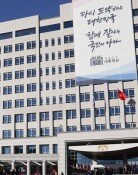Financial Soundness of Koreas Banks Worsening
Financial Soundness of Koreas Banks Worsening
Posted November. 10, 2008 08:25,
The soundness of Korean banks is worsening, and though the situation is not as serious as in the financial crisis of 1997-98, the worsening financial health of banks will undermine foreign investor trust in the Korean market.
Commercial banks are increasingly finding their hands tied since their attempts to improve indicators on their financial health will lead to lower lending to companies and households, resulting in more bankruptcies. Worse, banks are expected to suffer difficulty over a longer period of time, with the financial crisis showing signs of spreading to the real economy.
○ Falling BIS ratio and rising loan delinquencies
The capital adequacy ratios of commercial banks under Bank for International Settlements guidelines plummeted in the third quarter. Financial authorities blamed an increase in lending this year to small- and mid-size enterprises for the steep fall in the ratios.
Top lender Kookmin Bank saw its BIS ratio fall to 9.76 percent in the third quarter from 12.62 percent at the end of last year. Shinhans ratio dropped to 11.9 percent from 12.09 percent, Wooris 10.55 percent from 11.75 percent, and Korea Exchanges 10.6 percent from 11.4 percent.
The ratio of Hana Bank in the second quarter fell to 10.08 percent from 12.5 percent.
The BIS ratio fell to single digits because the bank bought back its shares worth 4.2 trillion won (3.1 billion U.S. dollars) to transform itself into a holding company, said a Kookmin source. The fall is temporary. The ratio will rise immediately if we sell the shares.
The BIS ratio rises when equity capital increases, which is possible through a cut in risk- weighted assets, a capital increase and issuance of collateralized bond obligation.
Kookmin will issue collateralized bond obligations worth 800 billion won (602 million dollars) today through Thursday. In September, Hana issued 390 billion won (293 million dollars) and Woori 200 billion won (150 million dollars) worth of subordinated bonds.
○ Rising loan delinquencies
In the third quarter, Kookmin saw its loan delinquency rate rise 0.11 percentage points to 0.68 percent and Shinhans grew 0.02 percentage points to 0.69 percent from the previous quarter. Wooris was 0.69 percent, up 0.13 percentage points, and Hanas 0.88 percent, up 0.17 percentage points.
According to the Bank of Korea, the delinquency rate of loans extended to small and mid-size companies rose to 1.59 percent from 1.1 percent at the end of last year. That of household lending grew to 0.68 percent in August from 0.56 percent at the end of last year.
With the situation deteriorating, banks are stockpiling enough provisions to cover a potential wave of debt defaults. The transfer rate of reserves for bad debts rose to 0.37 percent in the first half this year from 0.20 percent in the same period last year.
Non-banking sectors such as mutual savings banks and finance companies are also suffering from a credit crunch.
According to a report, finance companies issued last month a combined 145 billion won (109 million dollars) worth of bonds, up 80 percent from Septembers 739.8 billion won (556 million dollars).
Feeling the pinch from a liquidity shortage, Woori Financial Co., Ltd. asked for an injection of 300 billion won (225 million dollars) from its parent company Woori Finance Holdings. Hana Capital requested 200 billion won (150 million dollars) from Hana Bank.
Mutual savings banks and insurance companies are also at high risk of bankruptcy amid a slumping property market.
○ Loan collection to fuel bankruptcies
A more serious problem is that the weakening soundness of banks could take a huge toll on the real economy.
For their part, banks should either raise their capital adequacy ratios or reduce exposure to risky assets to maintain their financial strength. Financial authorities have asked banks to bolster their financial health by securing capital while maintaining the amount of loans to small and mid-size companies. At a time when the entire world is suffering from the financial crisis and the stock markets are wobbling, however, banks are having a tough time raising capital.
Against this backdrop, banks are likely to suspend lending and collect loans, something which will force numerous companies and households alike into bankruptcy.
Lee Jun-jae, a researcher at Korea Investment & Securities said, Banks have lowered their net profit forecasts for next year by 42.4 percent. They will have to restructure the property sector, in which they have heavily invested since 2000.
crystal@donga.com jaeyuna@donga.com







